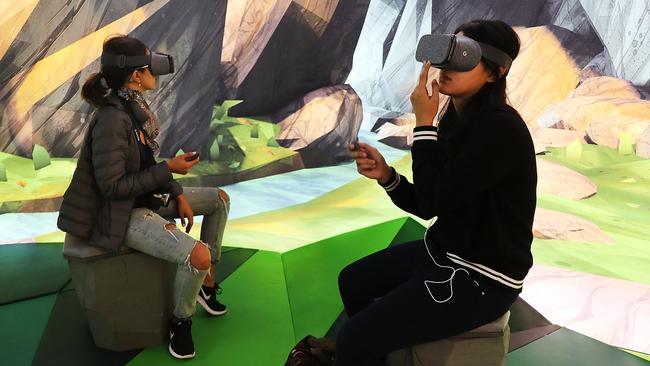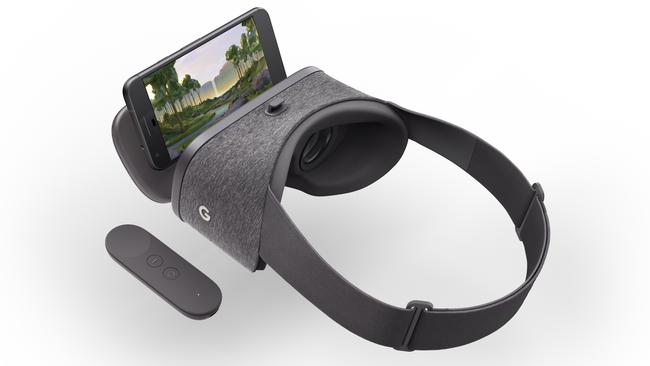Why Google’s Daydream View headset could be a dream come true for virtual reality
IT’S packed with tech, easy to use, and the most stylish way to strap a smartphone to your face. Could Google’s virtual reality headset change the game?

GOOGLE’S new virtual reality viewer is remarkably fashionable for something that straps a smartphone to your face.
The internet giant is throwing open the doors to its new virtual reality platform, Daydream, today, and delivering a new headset that looks remarkably different from its last crafty cardboard VR construction.
It’s so slick, the Daydream View doesn’t deserve to be mentioned in the same conversation as Google Cardboard, and out-styles its rivals while attaining a greater comfort level.
Plus, it’s part of a larger system, and a larger plan for mobile virtual reality.
But is the technology worth your time? And can Google make its Daydream a reality for mainstream audiences?
HOW IS DAYDREAM DIFFERENT?
Google’s new VR headset looks, feels, and operates differently to its rivals.
The Daydream View is not an all-plastic gadget, but a frame with a moulded foam mask covered in microfibre that sits over two lenses, and a soft slate fabric outside.
The headset’s strap is elasticated but won’t get caught in your hair, and its clasps are easy to move into position.

Google teamed with an unnamed apparel company to design the View, and the expertise shows, both in materials and design.
You can wear spectacles inside this headset — something only the PlayStation VR has been able to claim until now — and it doesn’t require a power source, just a powered remote control.
That control fits snugly into the viewer when not in use.
There are two niggles in its otherwise thoughtful and considered design.
With one strap around your head, but none over the top, users will need to tighten the headset firmly to prevent movement, and glasses wearers may be tempted to hold it up with one hand for comfort.
Light can also shine in through its sides, creating reflections, though this doesn’t significantly distract from the main show.
HOW DOES IT WORK?
Google sought to create an “unintimidating” virtual reality headset in the Daydream View and, ironically, added plenty of advanced technology to this device to make it simpler to use.
After downloading the Daydream app to a Google Pixel phone, users insert the handset into the front of this headset to watch it connect automatically.

You then connect its remote control by holding down one button, and follow instructions on the screen as the headset asks you to virtually explore an enchanted forest while you get your bearings.
The system is incredibly simple to use, and requires no understanding of what is really happening behind the scenes.
In case you want to know, Google has equipped the lid of the headset with an NFC chip to connect and communicate with your phone on contact.
Sensors on the View’s front help align its screen to prevent the need for calibration, and that simple, curved remote control features nine-axis movement sensors to track where you’re pointing, and let you select items, throw them, drag them about, or flip between screens without swivelling your head like Tasmanian Devil.
The benefit of this remote control cannot be overstated. It brings a new level of interaction to mobile virtual reality, and makes you feel more in control of your surroundings.
WHAT CAN YOU DO IN DAYDREAM?
Google’s new take on virtual reality is about so much more than just the headset.
Daydream is a new VR platform with more apps than you’d expect on debut — the company promises 50 apps by year’s end — and they’re getting help from existing products.

Google’s YouTube has long embraced 360-degree videos and they’re more compelling in VR.
Watching a 7m-long Rhomaleosaurus look me in the eye before swallowing a fish whole was equal parts magnificent and heart-pounding.
Google Streetview is also a star of the Daydream platform and delivers plenty of famous landmarks in 360 degrees, letting you roam the Taj Mahal or inspect Stonehenge close up. You simply select your perspective (a dot in the scene) using the remote control.
There are even literal news rooms for reading articles, star charts, real estate virtual tours, movie screening rooms from companies including Netflix, touching short films, and, of course, lots of games.
Driving, puzzle, and adventure games seem the most popular additions available so far, they’re priced like apps ($5, not $50), and Danger Goat is a puzzler well worth investigating.
WHAT COULD BE BETTER?
There so much that’s right with this headset, but there are minor irritations too.
As the headset is not wired into an expensive computer system with sensors in each corner of the room, you will need to re-centre its on-screen pointer.
It’s easy enough to do — you hold a button on the remote control until the pointer reappears in the correct location — but it’s a regular task.

Google’s Pixel phones are also not immune from heating up inside this cosy headset. Our Pixel XL became quite warm to touch after a 40-minute session, though it never stopped working.
Naturally, it also uses plenty of battery power while it keeps up with all the VR processing.
The Daydream app store is a great start, but it will be even better when all of the promised apps arrive, including Warner Bros’ Fantastic Beasts.
IS IT WORTH BUYING?
Google’s Daydream View is packed with advanced technology, could change the way you entertain and educate yourself, and costs $119.
That’s cheaper than Samsung’s Gear VR and the Zeiss VR One Plus, much cheaper than Sony’s PlayStation VR, and not even in the same ballpark as Oculus Rift and HTC Vive.
The one big caveat is that it currently requires a Google Pixel phone to work.
Google plans to introduce Daydream software to other Android phones in future, however — its partners include Samsung, LG, HTC, Huawei, ASUS and Alcatel — so it’s just a matter of time before this headset becomes a must-buy item for a wide audience.
Its design is a rare combination of style and comfort, it’s surprisingly simple to use even for the tech-adverse, and its VR repertoire is impressive and growing.
Samsung got to mobile virtual reality first, but Google may yet lead the way.
Google Daydream View
$119, store.google.com
4.5 out of 5 stars
Originally published as Why Google’s Daydream View headset could be a dream come true for virtual reality


